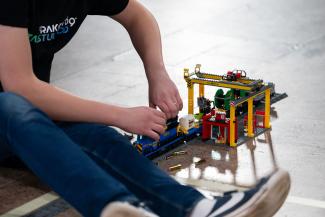
What is this challenge about?
The contestants are given two model trains facing each other on the same track. To avoid a collision, a bypass must be installed in the right place so that the trains can pass each other safely.
The acceleration and speed of the slow train are known. The contestants first must find out the speed of the express train. Based on the two speeds, the teams then must find the intersection point where the trains would meet in order to install the bypass.
Do you want to try it too?
Here are all the data you need:
Distance between the trains at the starting point: 6m
Slow train: Acceleration: 0.6 m in the first two seconds; Max. speed: 0.40 m/s
Express train: Acceleration: 0.7 m in the first two seconds; Max. speed: 0.7 m/s.
Infobox
Create a diagram showing the speeds of the two trains.
To do this, you need to create a time-distance diagram. Define the axes: the x-axis indicates the distance (in metres); the y-axis indicates the time (in seconds).
Now draw the diagram:
- Slow train: draw the first two points: the first is at 0m and 0 seconds; the second is at 0.6m and 2 seconds. From then on, the speed is constant, i.e. the train covers a distance of 0.4m every second. The next point comes at 1m and 3 seconds, and so on. Draw the next points and connect them with each other. Now you have the line of the slow train.
- Express train: The method is identical, except that the line must be drawn from right to left, as the express train starts at the other end of the track (i.e. at 6m). The first point of the express train is at 6m and 0 seconds, the second at 5.3m (6 - 0.7) and 2 seconds, the third at 4.6m (5.3 - 0.7) and 3 seconds, and so on. Now you can draw the line of the fast train.
Here is the diagram from the show:
Interpretation: The lines show how the positions of the trains change over time. The intersection of the two lines shows the time and position at which the trains meet. Build the centre of the bypass at this point.
Solution: The centre of the bypass must be installed at a distance of 2.3m from the starting point of the slow train.
Want to know how the participants from the show mastered this challenge?
Then watch episode no. 10! (Will be published on 9.03)
What is the scientific background to this challenge?
How can trains run on the same tracks without colliding? This must be carefully planned. The train driver and operations centre ensure a safe journey to begin with. On busy routes, multi-track systems are often used to separate trains travelling in opposite directions (i.e. one track for each direction). On less busy lines (e.g. in rural areas), trains sometimes share a track. In this case, train traffic is coordinated so that they are never on the same section at the same time.
Some history: Charles Ybry, a French engineer, is often mentioned as one of the first to systematically use time-distance diagrams (graphical timetables that regulate train traffic). Ybry developed a diagram in the 1940s to plan train movements on the line between Paris and Le Havre. It shows the distance (with stations) on the vertical axis and the time of day on the horizontal axis. Each train is assigned a diagonal line leading from the start to the destination. If two lines overlap, this means that two trains are in the same place at the same time and one or both must be rescheduled.
Railway systems, train control systems and digital versions of the time-distance diagram are used today to ensure the safety of train journeys.
Railway systems are the trackside signals along a railway line that transmit information about the route to the train driver. Important information includes whether and at what speed the train may travel or whether it must stop. This regulates the distance between two trains.
And if a train driver overlooks a signal? The automatic train control system, which monitors the speed and position of the trains and can brake automatically in an emergency, can help. This monitoring takes place by means of sensors installed in the trains themselves, in the tracks and at checkpoints.
Trains follow strict timetables that ensure that they are not on the same section of track at the same time. The track is divided into block sections. Only one train is allowed in a block section. The next train may only enter once the previous train has left the section. Time-distance diagrams are a useful tool for planning and visualising train journeys. Nowadays, digital models are used to analyse timetables instead of static graphs. These models are based on databases in which the entire timetable is stored as a network of nodes and edges, and software algorithms help to calculate routes.
A few impressions from the 10th episode



Author: Diane Bertel
Editor: Lucie Zeches (FNR)
Photos: Emmanuel Claude



